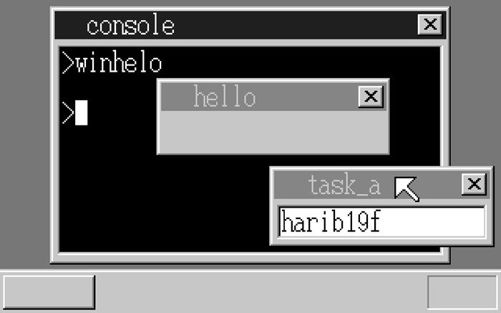6 显示窗口(harib19f)
用应用程序显示字符已经玩腻了,这次我们来挑战让应用程序显示窗口吧。这要如何实现呢?我们只要编写一个用来显示窗口的API就可以了,听起来很简单吧。
这个API应该写成什么样呢?考虑了一番之后,我们决定这样设计。
EDX = 5
EBX = 窗口缓冲区
ESI = 窗口在x轴方向上的大小(即窗口宽度)
EDI = 窗口在y轴方向上的大小(即窗口高度)
EAX = 透明色
ECX = 窗口名称
调用后,返回值如下:
EAX =用于操作窗口的句柄(用于刷新窗口等操作)
确定思路之后,新的问题又来了:我们没有考虑如何在调用API之后将值存入寄存器并返回给应用程序。
不过说起来,在asm_hrb_api中我们执行了两次PUSHAD,第一次是为了保存寄存器的值,第二次是为了向hrb_api传递值。因此如果我们查出被传递的变量的地址,在那个地址的后面应该正好存放着相同的寄存器的值。然后只要修改那个值,就可以由POPAD获取修改后的值,实现将值返回给应用程序的功能。
我们来按这种思路编写程序。
本次的console.c节选
int *hrb_api(int edi, int esi, int ebp, int esp, int ebx, int edx, int ecx, int eax){int ds_base = *((int *) 0xfe8);struct TASK *task = task_now();struct CONSOLE *cons = (struct CONSOLE *) *((int *) 0x0fec);struct SHTCTL *shtctl = (struct SHTCTL *) *((int *) 0x0fe4); /*从此开始*/struct SHEET *sht;int *reg = &eax + 1; /* eax后面的地址*//*强行改写通过PUSHAD保存的值*//* reg[0] : EDI, reg[1] : ESI, reg[2] : EBP, reg[3] : ESP *//* reg[4] : EBX, reg[5] : EDX, reg[6] : ECX, reg[7] : EAX */ /*到此结束*/if (edx == 1) {cons_putchar(cons, eax & 0xff, 1);} else if (edx == 2) {cons_putstr0(cons, (char *) ebx + ds_base);} else if (edx == 3) {cons_putstr1(cons, (char *) ebx + ds_base, ecx);} else if (edx == 4) {return &(task->tss.esp0);} else if (edx == 5) { /*从此开始*/sht = sheet_alloc(shtctl);sheet_setbuf(sht, (char *) ebx + ds_base, esi, edi, eax);make_window8((char *) ebx + ds_base, esi, edi, (char *) ecx + ds_base, 0);sheet_slide(sht, 100, 50);sheet_updown(sht, 3); /*背景层高度3位于task_a之上*/reg[7] = (int) sht; /*到此结束*/}return 0;}
shtctl的值是bootpack.c的HariMain中的变量,因此我们可以从0x0fe4地址获得。reg就是我们为了向应用程序返回值所动的手脚。
窗口我们就暂且显示在(100, 50)这个位置上,背景层高度3。
bootpack.c中也添加了1行。
本次的bootpack.c节选
void HariMain(void){(中略)*((int *) 0x0fe4) = (int) shtctl;(中略)}
■■■■■
我们编写这样一个应用程序来测试。
本次的a_nask.nas节选
_api_openwin: ; int api_openwin(char *buf, int xsiz, int ysiz, int col_inv, char *title);PUSH EDIPUSH ESIPUSH EBXMOV EDX,5MOV EBX,[ESP+16] ; bufMOV ESI,[ESP+20] ; xsizMOV EDI,[ESP+24] ; ysizMOV EAX,[ESP+28] ; col_invMOV ECX,[ESP+32] ; titleINT 0x40POP EBXPOP ESIPOP EDIRET
本次的winhelo.c
int api_openwin(char *buf, int xsiz, int ysiz, int col_inv, char *title);void api_end(void);char buf[150 * 50];void HariMain(void){int win;win = api_openwin(buf, 150, 50, -1, "hello");api_end();}
这些程序应该不用解释了吧?
■■■■■
我们来“make run”,好,快出现吧,窗口!……出来了!

显示出来了哦!
